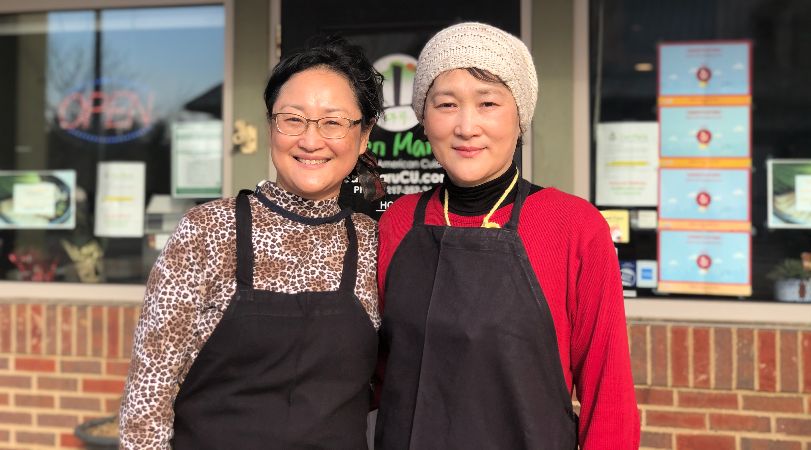San Maru is a Korean restaurant nestled between Rumberger’s Wings and El Patio in the Village at The Crossing in Champaign. This restaurant serves traditional Korean dishes like kimchi, bulgogi, bibimbop, and also spicy fried chicken wings. Remington reviewed San Maru a few months ago, reminding us about this hidden gem.
One afternoon between the lunch and dinner rush, I stopped by San Maru to have a masked chat with the owners and put in an order for an early dinner. Sitting at one of the four tables inside the restaurant with multiple air purifiers on blast, I asked the two sisters who own the place some questions about how they began the restaurant and how they’ve been affected by the pandemic.
The sisters shared with me the joys of growing up Korean, the unsavory reaction some had to kimchi, and the struggles of owning a restaurant in a pandemic.
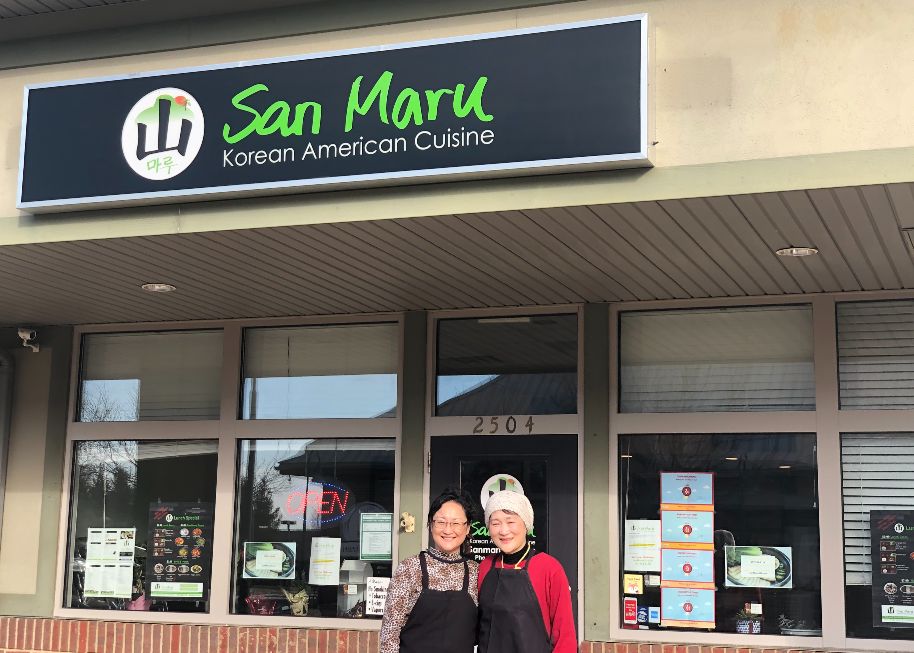
Photo by Alyssa Buckley.
Smile Politely: Hello! So happy to be able to chat with you both today. Can you please introduce yourselves?
Shinhee Cho: We are co-owners. My sister Deni Jung works in the kitchen, so she is the kitchen manager, and I work in the front of the house, so I’m general management and financial management.
SP: How do you decide who does what?
Cho: Most kitchen work belongs to her. From time to time, when she needs me, I will help, but it is rare.
SP: Let’s talk about the beginning of San Maru. You opened 5 years ago. What was it like when you first opened?
Cho: It was my first business, so it was a little bit scary because I encouraged her, my sister, to bring her family and come here from Virginia. I felt that I had to survive because not just for me, but for her family. It was my very first business.
I worked in a deli shop with sandwiches and soups, all American-style food. We have really good chicken wings here at San Maru because my sister and her husband developed the recipe when they were in Washington DC in 2005, or sometime, I cannot remember exactly.
Deni Jung: At some point, Washington Post named it one of the number ten. One of the top ten delis.
Cho: They were written about in the Washington Post, and the chicken wing, the teriyaki chicken, came here to our restaurant.

Photo by Alyssa Buckley.
SP: Are they the same wings on your menu today? The ones the Washington Post wrote about?
Cho: Oh yes. Our chicken wings are very popular. You need to try them.
SP: I’m going to have to order some of that. It sounds like it was a lot of pressure to succeed for yourself and for your sister’s family. What was it like when you first opened?
Cho: It was busy. It was very busy. We never expected that much business that first month. A lot of my friends and locals supported us. My sister’s food is great. Nobody expected real authentic Korean food made from scratch. Nobody expects us to have such great homecooking, same as in Korea. Or what would be considered superb in Korea. People just didn’t expect this.
When they tried, especially the soup seolleongtang (설렁탕), it’s boiled from the beef bones. We have to boil for an entire day with a couple of changing of the bones, take it and boil it again, and then mix together. It takes long hours to get the same consistency, but nobody expected this real Korean food.
Koreans love the soup. We make two kinds of soup. All our soup is homemade. The seolleongtang is milky white, and one is galbitang (갈비탕) is more clear. Tang means soup. All our soups come from these bases. We use these as the broth.
Jung: We have clear broth and milky white broth. All our soups use that kind of broth.
Cho: People know it’s different, with a lot of flavor, even if it is just a broth. It doesn’t have any vegetables except garnishing scallions. Even we don’t season it. People season with salt and pepper if they like. It’s just a plain beef soup, but I never expected Americans, Caucasion people who had never been exposed to Korean food, to like this soup, but actually they like it. A lot of my friends that I made here in Champaign, they tried the seolleongtang and they keep trying it.
SP: Can you talk to me about how the restaurant has changed in the time since it first opened five years ago?
Cho: We feel more settled, but we still struggle as women, as women-owners. We have to manage everything, and the everyday duties and work feels heavy. My sister is a perfectionist, so she does a lot of things by herself. The making the condiments from scratch, she just wants —
Jung: I want to make food how Mom made it. I want people to think, this is just how Mom made it. Customers think, “Oh, it tastes like Mom made it.” They taste it and say, “Tastes like Mommy’s cooking.”
SP: That’s quite the compliment.
Cho: Especially for Koreans, we have a lot of nostalgic feelings about food. For example, there is a Korean-Chinese noodle called jjajangmyeon (짜장면). It’s a black bean noodle soup. It’s not Korean; it’s Korean-Chinese. A lot of people say it’s not Chinese, but we consider it Chinese. Every Chinese restaurant in Korea, we can find there.
When I was young, we didn’t have a lot of outside food. When I was young, eating out meant going out to a Chinese restaurant and eating jjajangmyeon and tangsuyuk (탕수육)?
Jung: Same for me. Yeah.
Cho: Because, in our family, we like to go out on occasions. Every celebration, we go out.
Jung: Because it’s cheap food. It’s why.
Cho: Yeah, we go out to celebrate, and we go to a Chinese restaurant. Sometimes we —
Jung: Jjajang, always.
Cho: Sometimes we have more expensive food. We order the more expensive food sometimes, but most people just eat simple jjajang noodles. It’s a Chinese noodle, and even the Chinese, the people directly from China, they don’t recognize that. It’s a typical Chinese-Korean dish.
Jung: Now a hundred years ago, it is Chinese people coming to Korea and making the dish in Korean style. Korean-style noodles. Not Chinese noodles, but a Korean-Chinese noodle dish.
SP: I see. So people in Korean adopted this dish.
Jung: Yes, yes. This is a popular dish.
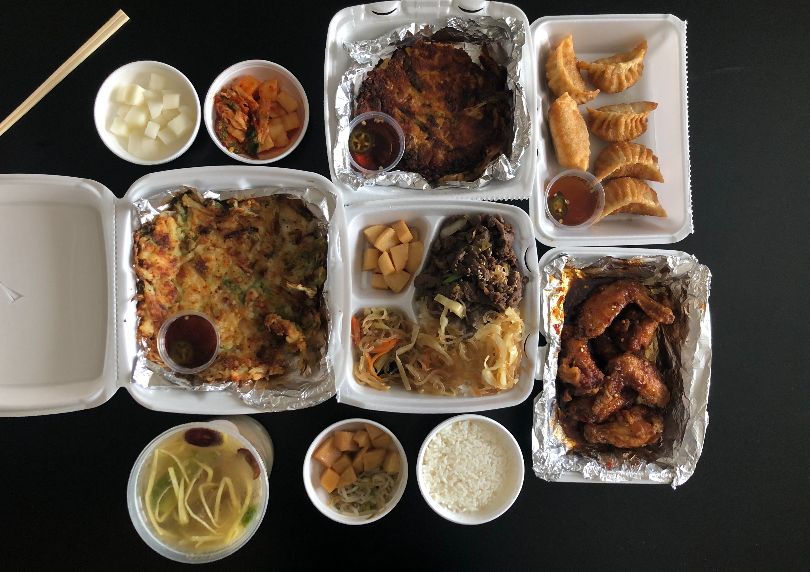
Photo by Alyssa Buckley.
SP: I’m hearing you talk about traditional Korean dishes. What makes a dish Korean? What is typical of Korean cooking style?
Cho: The Korean table setting is typically a bowl of rice, a bowl of soup, and we consider all the other things as side dishes. Even the meat, the bulgogi or galbi, as sides, but here in the United States, everybody thinks the meat dishes are the main, so we put the meat dishes in front of customers like a main entree. But originally, in Korea, the traditional Korean table setting is plain rice, rice that has been steamed in plain water, and a bowl of soup.
Jung: Banchan (반찬) is side dishes. We have five to seven of each.
Cho: Oh yes, seven banchan. All one table, lots of sharing. We call it not just appetizers. We don’t think you should preface lunch with an appetizer. Our country is a farming country, so we prepare a big breakfast, a heavy breakfast, then eat leftovers for lunch. Sometimes we make new foods, but lunch is simple. The most important meal is breakfast.
I realized here, that the farming society says the same thing. The farmers don’t eat just eggs and bread and cereal; no, they eat steak at breakfast with eggs. Fried steak because they have to work. So it’s the same thing. We always have bowl of rice, bowl of soup, and side dishes. Sometimes on special occasions, there are really nice dishes and a lot of side dishes. But most of the time, it is simple: rice, soup, kimchi, some vegetables, or one or two kinds of meat or fishes.
Everybody here likes meat as a main, so we put bulgogi or the meaty roasted things in front of you, but we still serve the traditional setting. We always put a bowl of rice for each and traditional side dishes to share.
SP: Every meal has rice and soup. That sounds lovely.
Jung: Except noodle dishes.
SP: Oh, if you had a noodle dish, you would not have rice with it?
Cho: No, noodle dishes, or dishes with noodles and rice, are a complete dish and do not need a side of rice. Like bibimbap (비빔밥), the most popular of Korean foods, was originally a leftover dish. Over the rice, we put every banchan with sauce, the hot sauce, sesame oil, and mix it all together. Sometimes kimchi.
Here, we want to present some nice dishes for people to enjoy. It’s not just my store, but all Korean restaurants have bibimbop. We put rice, many different vegetables, one kind of meat, usually the beef, and top of it, we put sesame oil, hot sauce, and mix it all together. It’s balanced and perfect for one meal. We consider every color of vegetable to have a different meaning and different nutrition. It’s true. We like to have that balance. It’s very healthy and very popular. Bibimbap is not a shared dish.
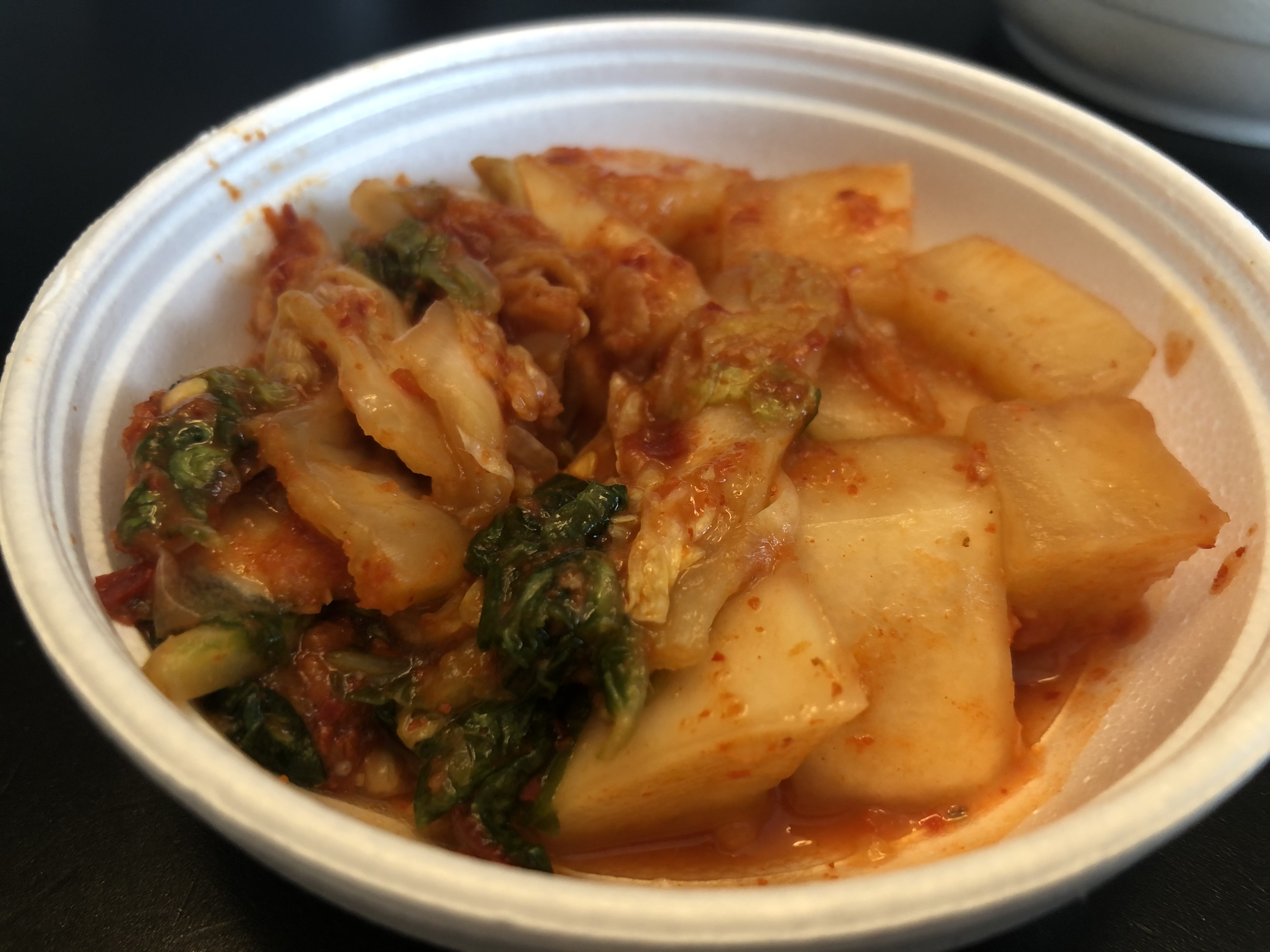
Photo by Alyssa Buckley.
SP: Let’s talk kimchi. I think it’s pretty popular. How do you guys make it?
Cho: When I was young, kimchi was not popular. Kimchi is essential food for Koreans, but it is not popular for other countries. Sometimes we are shamed because people say it has an awful smell, it is too sour, it is too spicy, it hurts our digestive system. People said because you eat that much kimchi, Koreans must get tummy cancer because of kimchi. A lot of people accused that when I was young. When I was young, it was true.
But at some point, in the late 80s and 90s, scientists studied Korean culture and diet and kimchi and how it affected their lifestyle and how Koreans survive longer, and they found kimchi is especially nice. The scientific study spread around Korean culture, and then finally people like kimchi.
When I came here in 1997, kimchi was not popular. Even the Japanese or Chinese did not like it at that time. Now, it is popular. Even if it is not the best smell, it has a good flavor and good nutrition. Now it is very good, and people really like it. Our kimchi is made fresh everyday. It’s a good sour, and that way people, non-Korean people can enjoy it more because it’s not fermented. The longer it sits, the more sour it is.
SP: I did not know that history of kimchi. Thank you for sharing that with me. I have always heard of kimchi in a positive light, and I am sorry that you felt shame about a food you enjoyed.
Cho: Kimchi is really good for your immune system. It’s a lot of spices, and it’s red and spicy. Ours is a moderate spice; you need to try it.
SP: Mung bean is used in Korean cooking. Do you have mung bean dishes or do you like cooking with mungbean?
Cho: We have mung bean pancakes. My family, my father came from North Korea a long time ago, and for our holidays, we always made mandoo and mung brean pancake. Mandoo is a potsticker, and the mung bean pancake is a traditional holy day pancake for my family.
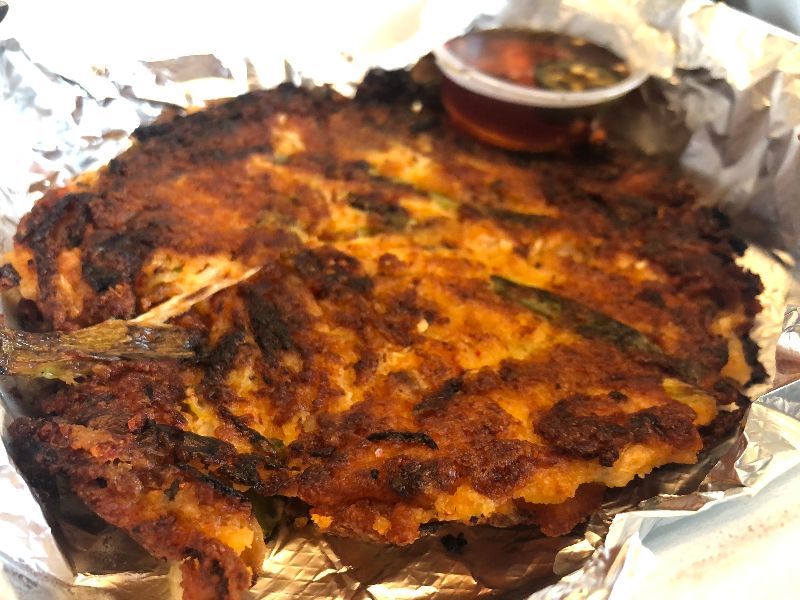
Photo by Alyssa Buckley.
At our restaurant, we have different kinds of pancakes on the menu like scallion and squid pancake, but most pancakes are made with wheat flour, but for mung bean pancakes, we use fresh ground mung bean instead of flour, so the texture is very different, very coarse.
Nokdu: with ground mung bean and a little bit of kimchi and sprouts with the mung bean is very good. I found other ethnic groups like mung bean pancakes, and they say they have similar dishes in their country. I don’t know the name, but a couple of Jewish people say they have similar things that they really like here. If you use similar ingredients like chickpeas, any kind of ground bean, it is similar to things like falafel. I thought the mung bean pancake was too typical for Koreans, so I did not recommend it to others, but I found that a lot of different ethnic groups here do like it.
SP: Korean cuisine uses a lot of vegetables. Do you have a favorite or a common vegetable in dishes?
Cho: We use napa cabbage; that’s the base of cabbage kimchi. We can make kimchi out of any kind of vegetables, but the most popular is napa cabbage. If we say kimchi, most people think of napa cabbage kimchi. We can made radish kimchi. We can make green onion, dandelion kimchi; any kind of vegetable, we can make into kimchi. We get the vegetables and season and store and eat during the winer months: that’s the basic of kimchi. We use a lot of cabbage.
Jung: Green onion. We use a lot of green onion.
Cho: We have some little potato dishes, complimentary to our customers. It’s very nice, and people really like it. Simmering in a sweet soy sauce, called gamja jorim (감자조림). Gamja is potato.
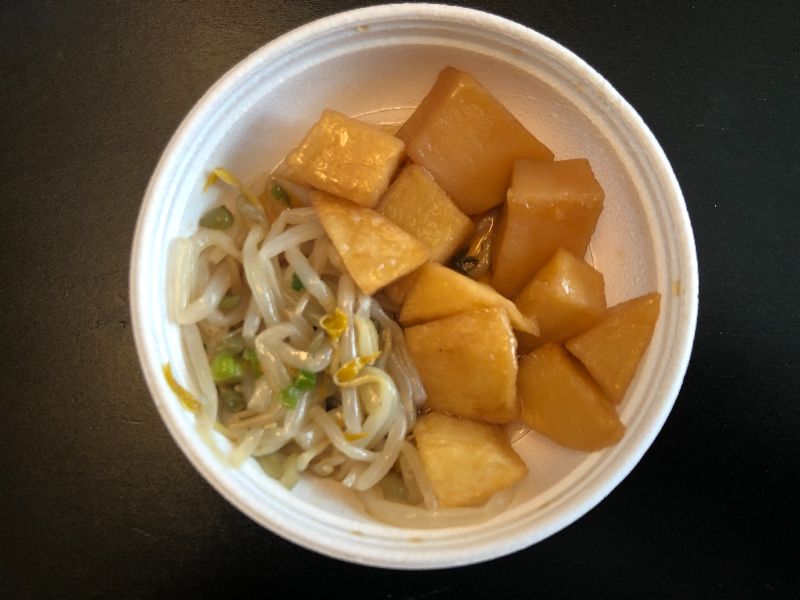
Photo by Alyssa Buckley.
SP: From what I’ve read online, it seems Korean food can be made into three categories (main, subsidiary dishes, or dessert).
Cho: Some people say rice is our main, but it’s hard to understand. Every meal has rice and soup, so that’s kind of main, but it’s not like you think. We call everything else banchan, or changeable. Main and secondary are different concepts. In my mind, main is not changeable. We eat rice and soup everyday, every meal. That makes rice and soup the main.
If we want to be satisfied, we need meat and some nice vegetables. As a mom, when I prepare the table, I make a meat dish and some kimchi and other small dishes and rice. In that way, the big dish in the middle is a main, but still, it is changeable, but rice is essential. Then it is dessert.
SP: Do you have dessert on your menu?
Cho: Yes, we have ice. We have snow ice. It’s a traditional way to eat, but not just for Koreans. You can find it like this in Japan, China, Taipei, Vietnam, and other countries, but ours is special. Originally, we made a block of ice and shaved it like Italian ice. Then we add sweet toppings to the ice and eat it. That’s the traditional way.
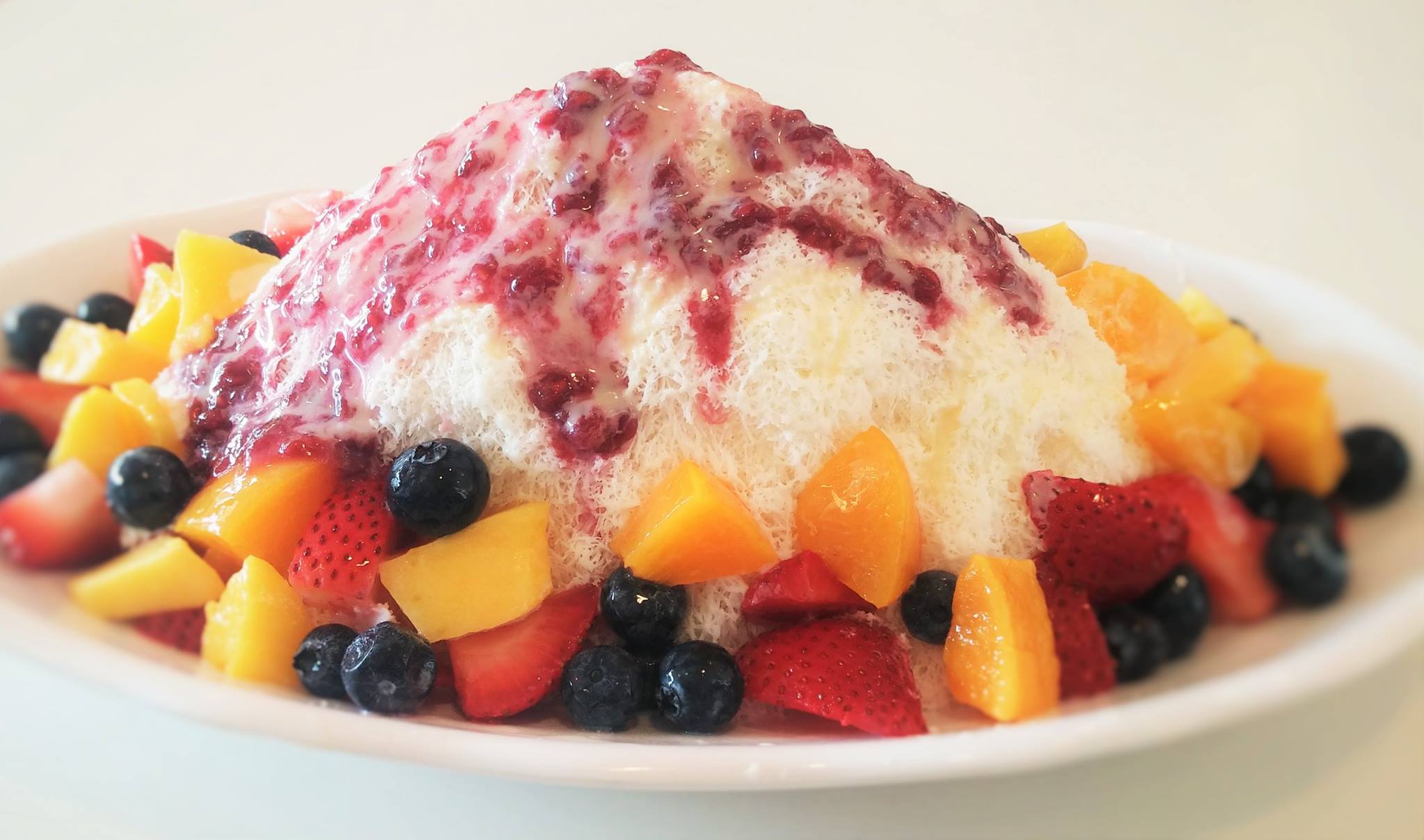
Photo from San Maru’s Facebook page.
Several years ago, somebody invented the snow ice machine, so we don’t need to make a big block of ice. We just pour any kind of liquid, and it makes snow, literally snow. It is so fluffy and nice — and a lot better than the shaved ice.
Jung: Also, we can pour any liquid.
Cho: Some people started using milk. Just think about the difference between plain water and milk, and how it is different. It is a lot creamier and sweeter, and we call it bingsu (빙수). Our mocha bingsu is made with mocha latte; it is really fabulous. Then we have one made with green tea latte. It’s really nice. It looks big, and it’s a good size to share with two or three or four. Sometimes people get it and they say, “Oh it’s so big!” but then they gobble it up. I can gobble it all by myself.
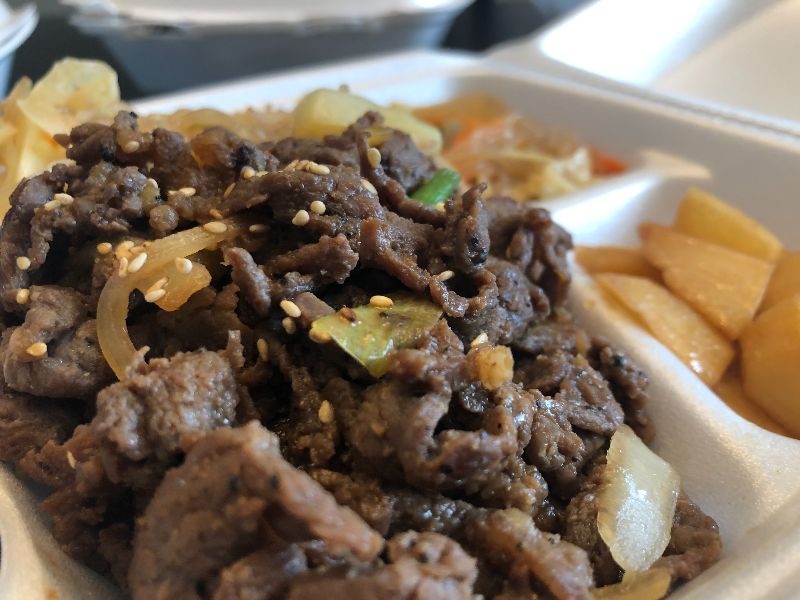
Photo by Alyssa Buckley.
SP: I saw a section of Takeout Boxes on your menu. Is that new?
Cho: It is new after COVID. Our table setting is rice and soup, but we put out the meat as a main. Meat and rice in the boxes, but still we give some complimentary side dishes. When you order a meal, it is a lot of small dishes, and it is a lot of disposable containers. I am really concerned about that, and I want to reduce the amount of takeout containers. We give generous portions, and we put all the side dishes in one box, not separate ones, so it just is my intention to reduce the waste of styrofoam containers for takeout.
We do one simple box with side dishes. I like to give choices to customers, and they can choose two different sides. It’s a three compartment box with rice, meat, and two sides for $10.99. People like to add mandoo or shrimps to the order, too. I think it’s satisfying for both customers and me.
SP: I think it’s a good idea. On Fridays, I saw you had a special for families. Is that still going?
Cho: Yes, still going. It is a big part of our restaurant. After COVID, it was hard to manage everything. I didn’t want to cut any employees. In the kitchen, their only job is this. They have families. If I cut them, they cannot survive. One of our guys, he works here part time. He used to work for a big restaurant in town, and they cut him off. How can he survive? He has a family. We need to survive. The kitchen workers, I want to keep them. My sister and I talked and talked. Then, finally we got some idea; I think it’s from God. We made these big family packages.
SP: What’s in the family pack?
Cho: The intent is for a family of four persons. We have some Korean main dishes that are partially cooked, and the customers will finish at home. Families can enjoy hot pot style dishes. Most Koreans love the shareable dishes. We prepare the big dish. On Friday night, the families can prepare their tables, and they pour all the ingredients in the bowl, add the broth, just to heat up, and then they can enjoy. That is the main dishes for Friday packages. It consists of marinated meat, like bulgogi we prepared but not cooked. They can put in the freezer to use later, too, if they want.
Some 11-13 dishes in one package. We cannot make a lot of these packages because it needs a lot of work besides the regular menu. Most of the special Friday package is outside the menu, so it needs a lot of extra work. We say 12 maximum orders for these packages. Except for special occasions.
For the holidays, you know in February we had two holidays, and we eat typical food. It was so popular. Usually, I post on Tuesday and close the orders on Wednesday nights, so we can prepare. Sometimes, it is usually ten orders, so we have some space, and I can take some home for my family. But, for the holiday food order, we had to close on Tuesday night. People asked, “We need some!” I had to tell them, “Sorry, it’s too much. We can’t.”
Jung: The family package helps us survive.
SP: Yes, and it sounds like if you want it, you need to sign up on Tuesday, so you don’t miss out. Can we talk about the pandemic? What has that been like being a restaurant owner?
Cho: The first couple of months, I was so anxious. I felt that it wasn’t just short term. I knew it was easily at least one year. We were so concerned about the health issues, but I didn’t know how to survive. God gave us this special family package idea, and that helped a lot. We can still work, and we can eat here — and we can help some other people. So, we can survive. We appreciate all these orders.
We got a PPP loan, and it covered some. I thought the government wanted to keep the workers, so I spent all the money on wages when we were closed. I gave them all the money. Then, the government said we can use the money for another purpose, but I had already spent it. The PPP loan was not enough to support all my workers through the closure, and we’re hoping the second PPP will help us. We appreciate the society and all the taxpayers. We have great customers and patrons.
I knew they didn’t need to eat takeout everyday, but they wanted to show us that they support us. One customer, she ordered one lunch for $12, and she gave $20 tip. I really wanted to share this story about another customer. I didn’t know her well, but she gave $500. Can you imagine? She just said, “You should keep this. I want to support you guys.”
After that, I think differently. I think, wow, that’s my society. This is my town. In this town, we have a lot of people with secure jobs and paychecks, and they want to spend. I knew a lot of people are not used to eating out this much, but they want to support us. After this, I changed my mind, and I eat a lot outside of this restaurant. I want to spend more money to support other restaurants, my neighbors especially. We can support each other. I’m so grateful that we have that kind of community.
SP: Where do you like to eat dinner in town?
Cho: I have two sons. They love hamburgers. I like a steakhouse. I don’t have any specific places. I like to try new restaurants, all kinds, Mexican restaurants. I try to eat at small restaurants like ours.
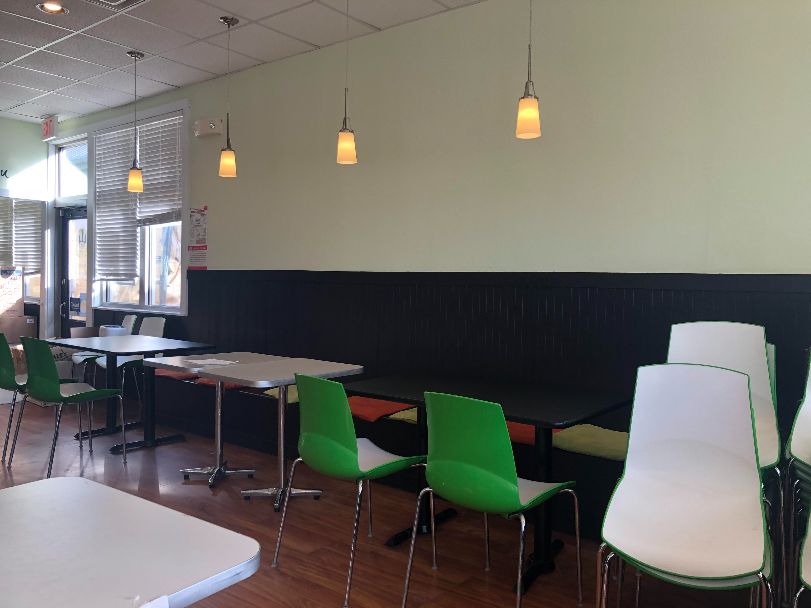
Photo by Alyssa Buckley.
SP: Can you talk about opening for indoor dining?
Cho: We opened inside. We have four tables. Legally, we can open more, but I don’t want to make anyone uncomfortable.
SP: Honestly, it looks like a great place for date night. So cozy.
Cho: We have four sanitized tables, and I bought two air purifiers. In 15 minutes, they clean even the COVID germs, according to the ad. I feel very confident about our indoor dining. We put together reservations because we don’t have space to wait for a table. People have started to slowly come and eat out.
SP: Anything else you want to share?
Cho: The Friday family special package is a big thing. It has our name, and it’s good for families because now it’s hard to make this food. If we have more time and space, I want to expand to offer this for more than the current 12 packages. It is great for families with small kids who can’t find time to cook dinner.
After COVID, probably we have a different society. I’m not sure how we survived, but hopefully we can keep going and expand more. I want to keep our pledge to home cooking and hopefully all people in this town will try our food and enjoy it.

Photo by Alyssa Buckley.
San Maru
2504 Village Green Pl
Champaign
T-Sa 11 a.m. to 2:30 + 4 to 9 p.m.








